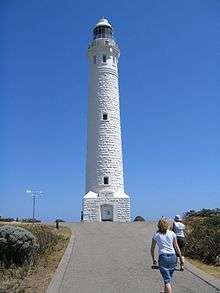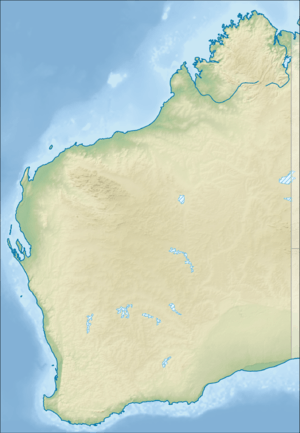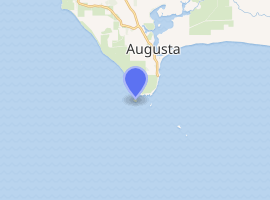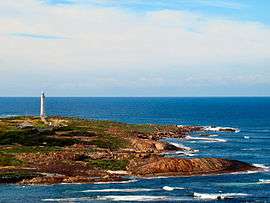Cape Leeuwin Lighthouse
The Cape Leeuwin Lighthouse is a lighthouse located on the headland of Cape Leeuwin, /ˈluːwɪn/ (![]()
 Cape Leeuwin Lighthouse | |
 Western Australia | |

| |
| Location | Cape Leeuwin Western Australia |
|---|---|
| Coordinates | 34°22′27″S 115°08′09″E |
| Year first lit | 1895 |
| Construction | limestone tower |
| Tower shape | cylindrical tower on square base |
| Markings / pattern | white tower and lantern |
| Tower height | 39 metres (128 ft) |
| Focal height | 57 metres (187 ft) |
| Original lens | 2nd order Chance Brothers Fresnel lens[1] |
| Characteristic | Fl W 7.5s. |
| Admiralty number | K1794 |
| NGA number | 8872 |
| ARLHS number | AUS-035 |
| Official name | Cape Leeuwin Lighthouse |
| Type | Listed place (Historic) |
| Designated | 22 June 2004 |
| Reference no. | 105416 |
| Type | State Registered Place |
| Designated | 13 May 2005 |
| Reference no. | 104 |
| Heritage | listed on the Commonwealth Heritage List |
Cape Leeuwin Lighthouse was constructed by a company led by M. C. Davies, with George Temple Poole supervising the construction of the light and designing the keepers’ quarters.[2] The light tower which is built of local stone was originally designed to show two lights – a higher white light and a lower red light. Although the foundations were completed, the lower light was never installed.[3] It was opened with great ceremony in 1895 by John Forrest, the Premier of Western Australia. Until June 1982 the lens was rotated by a counter weight driving clockwork mechanism, and the beacon was a pressure kerosene mantle type. A radio navigation beacon was commissioned in 1955 and operated until 1992.[3] The lighthouse was automated in 1982.[2] The lighthouse, besides being a navigational aid, serves as an important automatic weather station. The lighthouse's buildings and grounds are now vested in the local tourism body and the single (1960s) and double (1980s) communications towers that were north-west of the lighthouse, seen in older photographs of Cape Leeuwin, have been removed.
The nearest functioning lighthouse north of Cape Leeuwin is the much smaller Cape Hamelin lighthouse, just south of the Hamelin Bay camping area.
The young Felix von Luckner, later a German World War I war hero, noted for his long voyage on the Seeadler during which he captured 14 enemy ships, was briefly assistant lighthouse keeper. He abandoned the job when discovered with his hotel-keeper's daughter by her father.
International Lighthouse Day was celebrated at Cape Leeuwin lighthouse for the first time in 2004.[4] The climb to the viewing deck consists of 176 steps.[3]
Picture gallery
 Cape Leeuwin and lighthouse as seen from the north
Cape Leeuwin and lighthouse as seen from the north Cape Leeuwin seen from the east
Cape Leeuwin seen from the east Sign at Cape Leeuwin Lighthouse.
Sign at Cape Leeuwin Lighthouse. Lighthouse and cottages, Cape Leeuwin
Lighthouse and cottages, Cape Leeuwin The Fresnel lens in Cape Leeuwin lighthouse
The Fresnel lens in Cape Leeuwin lighthouse
See also
- List of lighthouses and lightvessels in Australia
References
- Rowlett, Russ. "Lighthouses of Australia: Western Australia". The Lighthouse Directory. University of North Carolina at Chapel Hill. Retrieved 21 July 2008.
- "Cape Leeuwin Lighthouse and Quarters". Heritage Council of Western Australia. Retrieved 2 August 2019.
- "History - Cape Leeuwin Lighthouse". Margaret River Attractions. Retrieved 20 June 2020.
- Lighthouses of Australia Inc. "Bulletin No 5/2004 - Sept/October 2004". Archived from the original on 4 March 2009.
External links
| Wikimedia Commons has media related to Cape Leeuwin Lighthouse. |
- "Cape Leeuwin Lighthouse". Lighthouses of Western Australia. Lighthouses of Australia Inc.
- Cape Leeuwin Lighthouse tour information
- - List of WA lighthouses - check link to Cape Leeuwin